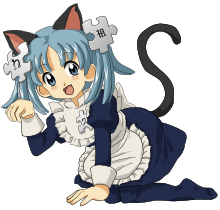
A catgirl (猫娘, nekomusume), sometimes called a neko girl or simply neko, is a young female character with feline traits, such as cat ears (猫耳, nekomimi), a cat tail, or other feline characteristics on an otherwise human body. They are not individuals who are literal cats but individuals who only look superficially feline. Catgirls are found in various fiction genres, particularly in Japanese anime and manga. Catboy is a term for the male equivalent of said character type.
History
The oldest mention of the term nekomusume comes from an 18th-century misemono (見世物) in which a cat/woman hybrid was displayed. Stories of shape-shifting bakeneko prostitutes were popular during the Edo period. The popularity of the nekomusume continued throughout the Edo and Shōwa periods, with many tales of cat/woman hybrids appearing in works such as the Ehon Sayoshigure (絵本小夜時雨) and Ansei zakki (安政雑記).
In Kenji Miyazawa's 1924 work, Suisenzuki no Yokka (水仙月の四日, literally The 4th of Narcissus Month) is the first modern day example of a beautiful, cat-eared woman. In 1936, the nekomusume experienced a revival in kamishibai. The first anime involving catgirls, titled The King’s Tail (Ousama no Shippo), was made in 1949 by Mitsuyo Seo. In America, the DC Comics character Catwoman first appeared in 1940, and Cheetah first appeared in 1943.
Catgirls were further made popular in 1978 manga series The Star of Cottonland, by Yumiko Ōshima. By the 1990s, catgirls were common in Japanese anime and manga. Catgirls have since been featured in various media worldwide. Enough of a subculture has developed for various themed conventions and events to be held around the world, such as Nekocon.
Catgirls are also popular among the furry fandom. In 2023, the furry hacker group SiegedSec attempted to blackmail the Idaho National Laboratory into "creating real-life catgirls".
Reception

Japanese philosopher Hiroki Azuma has stated that catgirl characteristics such as cat ears and feline speech patterns are examples of moe-elements. In a 2010 critique of the manga series Loveless, the feminist writer T. A. Noonan argued that, in Japanese culture, catgirl characteristics have a similar role to that of the Playboy Bunny in western culture, serving as a fetishization of youthful innocence.
See also
- Animal roleplay
- Furry fandom
- Human–animal hybrid
- List of catgirls and catboys
- Moe anthropomorphism
- Nekomata
References
- "Cat Girl". TV Tropes. Retrieved 2024-04-25.
- Okum, David (2004-03-24). "Cat Girl". Manga Madness. F+W Media. p. 72. ISBN 978-1-58180-534-5.
- ^ Davisson, Zack (2017). Kaibyō : the supernatural cats of Japan (First ed.). Seattle, WA: Chin Music Press. ISBN 978-1-63405-916-9. OCLC 1006517249.
- "Suisenzuki no yokka". www.aozora.gr.jp (in Japanese). Archived from the original on September 23, 2015. Retrieved March 15, 2015.
- Wallace, Daniel (2010). "1940s". In Dolan, Hannah (ed.). DC Comics Year By Year A Visual Chronicle. Dorling Kindersley. p. 31. ISBN 978-0-7566-6742-9.
The first issue of Batman's self-titled comic written by Bill Finger and drawn by Bob Kane, represented a milestone in more ways than one. With Robin now a partner to the Caped Crusader, villains needed to rise to the challenge, and this issue introduced two future legends: the Joker and Catwoman.
- Berndt, Jaqueline (1995). Phänomen Manga : Comic-Kulture in Japan (in German). Berlin: Edition q. p. 111. ISBN 978-3-86124-289-5.
- ^ Azuma, Hiroki (2009). Otaku: Japan's database animals. Translated by Abel, Jonathan; Kono, Shion (English ed.). Minneapolis: University of Minnesota Press. pp. 47, 89. ISBN 978-0-8166-6800-7. OCLC 527737445.
- "After Action Report". The Virginian-Pilot. 2007-11-07. Archived from the original on 2016-09-14. Retrieved 2013-02-03.
- Yeo, Amanda (2023-11-24). "'Gay furry hackers' breach nuclear lab, demand it create catgirls". Mashable. Retrieved 2024-08-03.
- Galbraith, Patrick W. (31 October 2009). "Moe and the Potential of Fantasy in Post-Millennial Japan". Electronic Journal of Contemporary Japanese Studies. 9 (3). Archived from the original on 2019-10-25. Retrieved 2018-05-23.
- Noonan, T. A. (Fall 2010). ""I Can't Get Excited for a Child, Ritsuka": Intersections of Gender, Identity, and Audience Ambiguity in Yun Kôga's Loveless" (PDF). MP: An Online Feminist Journal. 3 (2). ISSN 1939-330X. Archived (PDF) from the original on 12 January 2016. Retrieved 10 February 2013.
External links
| Stock characters | |||||||||||||||||||||||||||||||||||||||||
|---|---|---|---|---|---|---|---|---|---|---|---|---|---|---|---|---|---|---|---|---|---|---|---|---|---|---|---|---|---|---|---|---|---|---|---|---|---|---|---|---|---|
| |||||||||||||||||||||||||||||||||||||||||
| |||||||||||||||||||||||||||||||||||||||||
| |||||||||||||||||||||||||||||||||||||||||